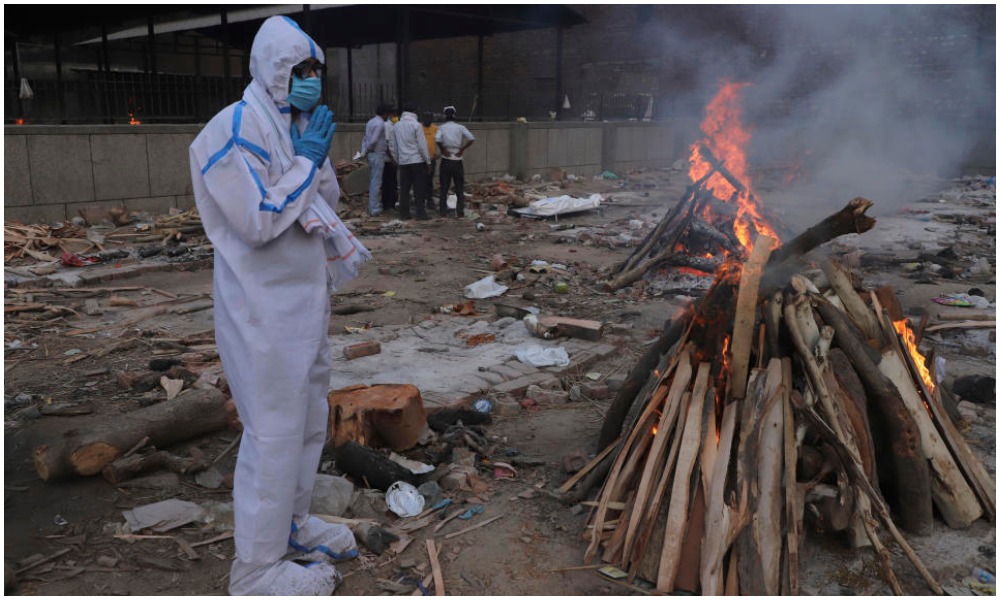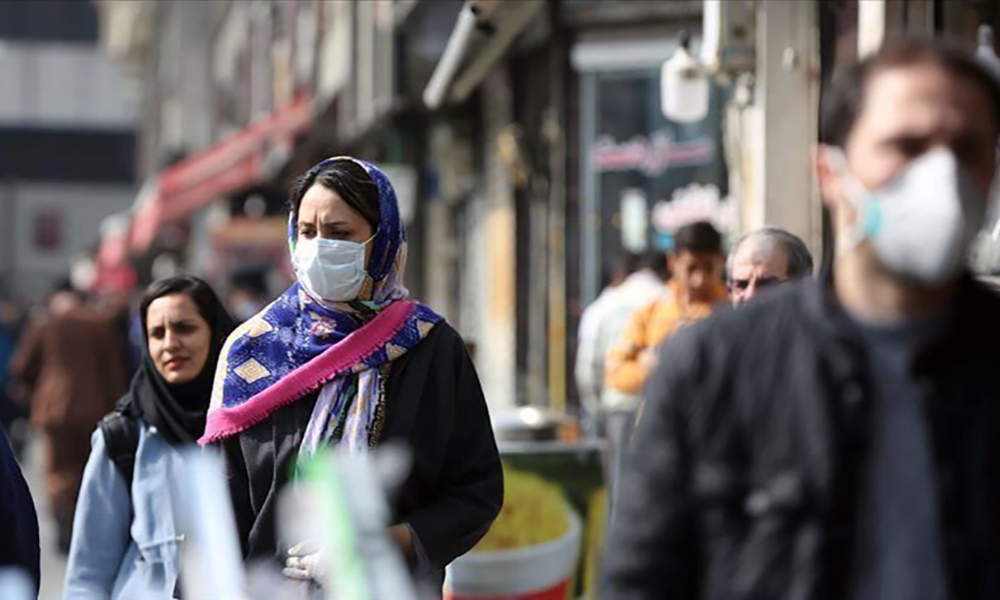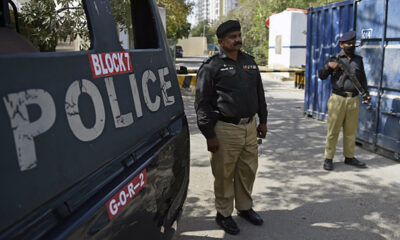COVID-19
India’s COVID-19 deaths cross quarter million as virus ravages countryside

India’s coronavirus deaths crossed a quarter million on Wednesday in the deadliest 24 hours since the pandemic began, as the disease rampaged through the countryside, overloading a fragile rural healthcare system.
Boosted by highly infectious variants, the second wave erupted in February to inundate hospitals and medical staff, as well as crematoriums and mortuaries. Experts are still unable to say with certainty when the figures will peak.
Deaths swelled by a record 4,205 while infections rose 348,421 in the 24 hours to Wednesday, carrying the tally past 23 million, health ministry data showed. Experts believe the actual numbers could be five to 10 times higher, however.
Funeral pyres have blazed in city parking lots, and scores of bodies have washed up on the banks of the holy river Ganges, having been immersed by relatives whose villages were stripped bare of the wood needed for cremations.
Lacking beds, drugs and medical oxygen, hospitals have been forced to turn away droves of sufferers, while tales of desperate relatives searching for someone to treat dying loved ones have become sickeningly commonplace.
Many victims die without a doctor on hand to issue a death certificate, and even when a doctor is available, COVID-19 is not specified as the cause of death unless the deceased was tested for the disease, which few have been.
Although the infection curve may be showing early signs of flattening, new cases are likely to fall off slowly, said top virologist Shahid Jameel.
“We seem to be plateauing around 400,000 cases a day,” the Indian Express newspaper quoted him as saying.
“It is still too early to say whether we have reached the peak.”
India, with a population of 1.4 billion, accounts for half of cases and 30% of deaths worldwide, the World Health Organization said in its latest weekly report.
The full impact of the B.1.617 variant found in India, which the agency has designated as being of global concern, is not yet clear, it added.
RURAL SPREAD
Daily infections are shooting up in the countryside in comparison to big towns, where they have slowed after last month’s surge, experts say.
More than half the cases this week in the western state of Maharashtra were in rural areas, up from a third a month ago. That share is nearly two-thirds in the most populous, and mainly rural, state of Uttar Pradesh, government data showed.
Television showed images of people weeping over the bodies of loved ones in ramshackle rural hospitals while others camped in wards tending to the sick.
A pregnant woman was taking care of her husband who had breathing difficulties in a hospital in Bhagalpur in the eastern state of Bihar that is seeing a surge its health system could barely have handled at the best of times.
“There is no doctor here, she sleeps the whole night here, taking care of her husband,” her brother told India Today television.
In a corridor outside, two sons were wailing over the body of their father, saying repeatedly that he could have been saved if only he had been given a bed in an intensive care unit.
At the general hospital in Bijnor, a town in northern Uttar Pradesh, a woman lay in a cot next to a garbage can and medical waste.
“How can someone get treated if the situation is like this?” asked her son, Sudesh Tyagi. “It is a hell out here.”
COVID-19
WHO declares end to COVID global health emergency

The World Health Organization said Friday that COVID-19 no longer qualifies as a global emergency, marking a symbolic end to the devastating coronavirus pandemic that triggered once-unthinkable lockdowns, upended economies and killed millions of people worldwide.
The announcement, made more than three years after WHO declared the coronavirus an international crisis, offers some relief, if not an ending, to a pandemic that stirred fear and suspicion, hand-wringing and finger-pointing across the globe, AP reported.
The U.N. health agency’s officials said that even though the emergency phase was over, the pandemic hasn’t finished, noting recent spikes in cases in Southeast Asia and the Middle East.
WHO says thousands of people are still dying from the virus every week, and millions of others are suffering from debilitating, long-term effects.
“It’s with great hope that I declare COVID-19 over as a global health emergency,” WHO Director-General Tedros Adhanom Ghebreyesus said.
“That does not mean COVID-19 is over as a global health threat,” he said, warning that new variants could yet emerge. Tedros noted that while the official COVID-19 death toll was 7 million, the real figure was estimated to be at least 20 million.
Tedros said the pandemic had been on a downward trend for more than a year, acknowledging that most countries have already returned to life before COVID-19.
He bemoaned the damage that COVID-19 had done to the global community, saying the pandemic had shattered businesses, exacerbated political divisions, led to the spread of misinformation and plunged millions into poverty.
When the U.N. health agency first declared the coronavirus to be an international crisis on Jan. 30, 2020, it hadn’t yet been named COVID-19 and there were no major outbreaks beyond China.
More than three years later, the virus has caused an estimated 764 million cases globally and about 5 billion people have received at least one dose of vaccine.
In the U.S., the public health emergency declaration made regarding COVID-19 is set to expire on May 11, when wide-ranging measures to support the pandemic response, including vaccine mandates, will end. Many other countries, including Germany, France and Britain, dropped most of their provisions against the pandemic last year.
When Tedros declared COVID-19 to be an emergency in 2020, he said his greatest fear was the virus’ potential to spread in countries with weak health systems.
Most recently, WHO has struggled to investigate the origins of the coronavirus, a challenging scientific endeavor that has also become politically fraught.
COVID-19
COVID-19 in Iran: Nearly 900 new cases, 24 deaths recorded

The Iranian health ministry announced on Sunday that more than 890 new cases of COVID-19 have been identified across the country during the past 24 hours, adding that 24 patients have died in the same period of time, Fars News Agency reported.
“A sum of 891 new patients infected with COVID-19 have been identified in the country based on confirmed diagnosis criteria during the past 24 hours,” the Iranian Health Ministry’s Public Relations Center said on Sunday, adding, “454 patients have been hospitalized during the same time span.”
The ministry’s public relations center said 611 people infected with COVID-19 are in critical condition.
COVID-19
China says 200 million treated, pandemic ‘decisively’ beaten

China says more than 200 million of its citizens have been diagnosed and treated for COVID-19 since it lifted strict containment measures beginning in November.
With 800,000 of the most critically ill patients having recovered, China has “decisively beaten” the pandemic, according to notes from a meeting of the ruling Communist Party’s all-powerful Politburo Standing Committee presided over by President and party leader Xi Jinping, AP reported.
China enforced some of the world’s most draconian lockdowns, quarantines and travel restrictions and still faces questions about the origins of the virus that was first detected in the central Chinese city of Wuhan in late 2019. Heavy-handed enforcement prompted rare anti-government protests and took a heavy toll on the world’s second-largest economy.
The official Xinhua News Agency quoted Xi as saying that policies to control the outbreak had been “entirely correct.” The abrupt lifting in November and December of the “zero COVID” policy that had sought to eliminate all cases of the virus led to a surge in infections that temporarily overwhelmed hospitals.
Case numbers have since peaked and life has largely returned to normal, although international travel in and out of China has yet to return to pre-pandemic levels.
China is now transitioning to a post-pandemic stage after a fight against the outbreak that was “extraordinary in the extreme,” Xinhua said.
The government will continue to “optimize and adjust prevention and control policies and measures according to the times and situations with a strong historical responsibility and strong strategic determination,” Xinhua said.
-

 Sport5 days ago
Sport5 days agoACL fever grows as fixtures finalized
-

 Latest News5 days ago
Latest News5 days agoOver 50 people dead in traffic accidents over Eid
-

 Latest News5 days ago
Latest News5 days agoUS identifies Kabul airport suicide bomber
-

 Business5 days ago
Business5 days agoAfghanistan-Kazakhstan chamber of commerce opens in Herat
-

 World4 days ago
World4 days agoIsraeli military vows response to Iran attack as calls for restraint mount
-

 Sport3 days ago
Sport3 days agoATN secures exclusive rights to broadcast Paris 2024 Olympics
-

 Latest News4 days ago
Latest News4 days agoPakistani police give Afghans in Balochistan one day to leave
-

 Latest News4 days ago
Latest News4 days agoHekmatyar slams US for ‘occupying’ Afghanistan’s airspace
























